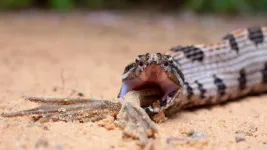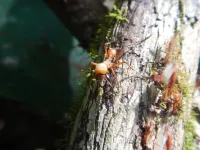(Press-News.org) Diversity in diet plays a role in the complexity of venom in pit vipers such as rattlesnakes, copperheads and cottonmouths.
But new collaborative research by Clemson University scientists found the number of prey species a snake ate did not drive venom complexity. Rather, it was how far apart the prey species were from each other evolutionarily.
"It's not just diet that drives the variation in venom across snakes. It's the breadth of diet," said Christopher Parkinson, a professor in the College of Science's Department of Biological Sciences. "If a snake eats 20 different species of mammals, its venom will not be very complex. But if it eats a centipede, a frog, a bird and a mammal, it's going to have a highly complex venom because each component of that venom is affecting something different in one of the different animals the snake is feeding upon."
The journal Proceedings of the National Academy of Sciences published the findings in a paper titled "Phylogenetically diverse diets favor more complex venoms in North American pit vipers."
The research could lead to better anti-venoms and serve as a dietary database for other snake researchers.
"Snakebite is a neglected tropical disease. It doesn't kill many people in the U.S., only around eight per year. But it causes lasting injury such as neurological and tissue damage. Even though we have good anti-venoms, they could certainly be better. We have produced a library of the venoms of all the species in the U.S. in a higher level of detail than has been done before, so somebody else who is interested in improving anti-venoms could use this information," said Matthew Holding, a former Clemson postdoctoral researcher who is the lead author of the paper.
Holding collaborated with researchers from Clemson, Florida State University, Mexico and Brazil to study the venoms and diets of 46 species of North American pit vipers, including all that live in the United States. They next used information about the diets of those species to understand why some venoms are simple and others are very complex.
Venoms contain proteins that collectively function to incapacitate prey. The number of different proteins it contains reflects its complexity.
"You can think of venom as a snake's toolbox," said Holding, who is now a National Science Foundation Postdoctoral Research Fellow at Florida State. "A wrench, a socket and a screwdriver each have a different use. Likewise, each protein has a different function when the venom is injected into a mouse, lizard or centipede or whatever prey the snake is eating."
"Some snakes have much simpler venoms with fewer components. Some have many more. We wanted to understand, from an evolutionary standpoint, why that might be, Holding explained."
Researchers collected venom and venom gland samples from rattlesnakes and cottonmouths across North America. They used next-generation sequencing techniques to generate the largest dataset of proteomes and venom-gland transcriptomes for viperid snakes to date.
Using natural history specimens, researchers compared venom complexity to snake species' diets.
"Having a prey database based on natural history specimens was paramount because we could not have done this work without those museum collections. We could not have built a comparative phylogenetic framework to compare snakes' diet and evolutionary history without them," said Parkinson, who has a dual appointment in the College of Agriculture, Forestry and Life Science's Department of Forestry and Environmental Conservation.
Holding said venom complexity changes in association with the phylogenetic diversity of snake diets, with the evolution of both simpler and more complex venoms. The study shows the amount of divergence among prey species matters for the evolution of targeted venoms, rather than only differences among prey species or major taxonomic groups, regardless of how they are phylogenetically related.
Some previous studies have hinted that diet probably caused variation in venom across snakes using coarse data. This project utilized venom gland genetic data for more than 250 individual snakes, a denser sampling that any other study to date. The researchers also compiled a detailed prey item database. Combining these data facilitated understanding of the cause of venom variation.
"Because we use next-generation sequencing tools, we could do more than counting up the number of components in the venom. We could get much closer to the genetic sequences that are contributing to this trait in these taxa, which had not been done before," Holding said.
The study showed that diet diversity predicts expressed complexity in three of the four largest venom gene families in viper venoms. Serine proteases, metalloproteinases and phospholipases had a positive relationship, meaning the more diverse the snake's diet, the more complex its venom. But diet did not have the same effect on c-type lectins. Diet diversity accounts for between 25 and 40 percent of variation in venom complexity.
"We generated new questions for other researchers to tackle, such as why c-type lectins follow a different pattern of relationship to diet diversity than other gene families and what explains the remaining three-fourths of variation in venom complexity for which we are unable to account," Holding said.
Since snake venom-derived drugs are used to treat heart disease, high blood pressure and blood clots in humans, the better scientists understand venom, the more likely they can use it to create human medicines.
"We see the downstream potential for medical or therapeutic uses. But what gets us excited is asking, 'Why there are so many types of snakes in the first place, and within those snakes, why are there so many types of venom that have so many effects on either prey or people?' " Holding said.
INFORMATION:
This project was supported by the National Science Foundation and the Fundacao de Amparo a Pesquisa do Estado de Sao Paulo. The content is solely the authors' responsibility and does not necessarily represent the official views of the supporting organizations.
The College of Science pursues excellence in scientific discovery, learning and engagement that is both locally relevant and globally impactful. The life, physical and mathematical sciences converge to tackle some of tomorrow's scientific challenges, and our faculty are preparing the next generation of leading scientists. The College of Science offers high-impact transformational experiences such as research, internships and study abroad to help prepare our graduates for top industries, graduate programs and health professions. Clemson.edu/science
Antibiotics on the cocoon protect the offspring of beewolves, a group of digger wasps, from detrimental fungi. These protective substances are produced by symbiotic bacteria of the genus Streptomyces, which live in these insects. In a new study in PNAS, researchers from the Max Planck Institute for Chemical Ecology and the University of Mainz, together with an international team, showed that these beneficial bacteria are losing genetic material that is no longer needed. The genome of these bacteria is of great interest for understanding the process of genome erosion and elucidating how the cooperation and the mutual benefit between bacteria and their host insects have evolved over long periods of time (PNAS, doi: 10.1073/pnas.2023047118, ...
Police violence against Black Americans is shamefully common in the United States and devastates communities. For incidents that get widespread media exposure, a collective trauma is felt across the nation, especially for Black individuals. Research supports that experiencing racism even vicariously can harm the mental and physical health of others of the same racial group, yet its effect on a population level is unclear.
A new study analyzed how highly publicized acts of racial violence impacted the mental health of Black Americans in the U.S. The authors identified 49 incidents that occurred between 2013 and 2017, including police killings of Black individuals, hate-crime murders and decisions not to indict or convict the officers involved. The researchers measured ...
What keeps some plants squatting close to the soil while others - even those closely related - reach high for the skies?
New research addressing the architecture and growth habit of plants has provided an answer to this question and may assist in the development of better performing crops.
The way plants grow must sometimes satisfy contradictory needs. Growing close to the ground, decreases the chances of being grazed, but this presents the need to rise rapidly to allow seeds to disperse. This can be observed in dandelions and in Arabidopsis, a model species commonly used to study plant development.
Agriculture has taken advantage of the diversification of growth habit so that ...
Like superheroes capable of seeing through obstacles, environmental regulators may soon wield the power of all-seeing eyes that can identify violators anywhere at any time, according to a new Stanford University-led study. The paper, published the week of April 19 in Proceedings of the National Academy of Sciences (PNAS), demonstrates how artificial intelligence combined with satellite imagery can provide a low-cost, scalable method for locating and monitoring otherwise hard-to-regulate industries.
(WATCH VIDEO: https://www.youtube.com/watch?v=LHvRgKmJOK8)
"Brick kilns have proliferated across Bangladesh to supply the growing economy with construction materials, which makes it really hard for regulators to keep up with new kilns that are constructed," ...
A new type of collective behaviour in ants has been revealed by an international team of scientists, headed by biologist Professor Iain Couzin, co-director of the Cluster of Excellence "Centre for the Advanced Study of Collective Behaviour" at the University of Konstanz and director at the co-located Max Planck Institute of Animal Behavior, and Matthew Lutz, a postdoctoral researcher in Couzin's lab. Their research shows how ants use self-organized architectural structures called "scaffolds" to ensure traffic flow on sloped surfaces. Scaffold formation results from individual sensing and decision-making, ...
Researchers at Baylor College of Medicine and collaborators at other institutions have discovered that POT1, a gene known to be associated with risk of glioma, the most common type of malignant brain tumor, mediates its effects in a sex-specific manner. Researchers found that female mice with glioma that lacked the gene survived less than males. This led them to investigate human glioma cells, where they found that low POT1 expression correlated with reduced survival in females.
Published in the journal Cancer Research, the study also shows that, compared to males', female tumors had reduced expression of immune signatures and increased expression of cell replication markers, suggesting that the immune response and tumor cell proliferation seemed to be ...
Scientists at VCU Massey Cancer Center have identified a protein that operates in tandem with a specific genetic mutation to spur lung cancer growth and could serve as a therapeutic target to treat the disease.
Mutations in the p53 gene are found in more than half of all cancers, but it remains difficult to effectively target the gene with drugs even decades after its discovery. Though previous research has shown that p53 acts as a tumor suppressor and initiates cancer cell death in its natural state, a new study led by Sumitra Deb, Ph.D., suggests that gain-of-function (GOF) mutations -- a type of mutation where the changed gene has an added function ...
LOS ALAMOS, N.M., April 19, 2021--A new machine-learning program accurately identifies COVID-19-related conspiracy theories on social media and models how they evolved over time--a tool that could someday help public health officials combat misinformation online.
"A lot of machine-learning studies related to misinformation on social media focus on identifying different kinds of conspiracy theories," said Courtney Shelley, a postdoctoral researcher in the Information Systems and Modeling Group at Los Alamos National Laboratory and co-author of the study that was published last week in the Journal of ...
PHILADELPHIA-- A retrospective study led by researchers from Penn Medicine found that with MitraClip for treatment of secondary mitral regurgitation (MR), a heart disease associated with problems in the left ventricle, there was no negative effect of having a slightly smaller mitral valve opening as long as there was good reduction of the mitral regurgitation. The study is published today in JACC: Cardiovascular Interventions.
"This data is very reassuring for physicians who place MitraClips in patients with secondary mitral regurgitation. It demonstrates that the benefits of MR reduction in patients with heart failure were maintained even when mild-to-moderate mitral stenosis, which can be caused by a narrowing of the ...
While cardiovascular disease (CVD) remains the leading cause of death globally, new research led by NYU Grossman School of Medicine and Moi University School of Medicine (Kenya) found that addressing and incorporating social determinants of health (such as poverty and social isolation) in the clinical management of blood pressure in Kenya can improve outcomes for patients with diabetes or hypertension.
The study -- recently published online in The Journal of the American College of Cardiology - found that after one year, patients who received a multi-component intervention that combined community microfinance groups with group medical visits (where patients with similar medical conditions met together with a clinician and community health worker) ...






